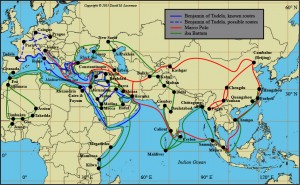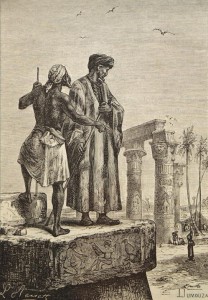The Travels of Ibn Battutah
MECHANICSVILLE, Va.—Marco Polo is much more better known in the west, if only for the kids’ game I had never heard of prior to a television commercial a few years ago.
Abū ʿAbd al-Lāh Muḥammad ibn ʿAbd al-Lāh l-Lawātī ṭ-Ṭanǧī ibn Baṭūṭah, a.k.a. Ibn Battutah, is not. I cannot remember any cultural references, any discussions of his travels or of his writings until I began graduate studies in geography at the University of Oklahoma in 1983.
I deduced from the whispered, jazz-like references to him that he was considered cool in geographic circles—someone who contributed greatly to our knowledge of the cultural and physical geography of the medieval world; one of the greatest, if arguably unintentional, geographers in history.
That observation was confirmed when I began teaching undergraduate geography in the current century and frequently noticed his name in the introductory discussions of the history of geography that usually whooshed by in the first chapter of the textbooks I used in my cultural, physical, and world regional geography classes.
Just as it took me some time to read Aldo Leopold’s A Sand County Almanac, embrace jazz, or learn to scuba dive, it took me some time to see what all the whispering among my fellow geographers was about.
I am glad I finally followed up.
Ibn Battutah is every bit the adventurer and storyteller that Marco Polo was, and it frankly is a damned shame that he is not as widely known in Western popular culture as is the legendary Venetian. (Although, one can legitimately argue that the Venetian’s writing had a greater impact on Western culture than Ibn Battutah’s work has had.)

Caravan of pilgrims in Ramleh (31st Maqamat), a painting by Yahyâ ibn Mahmûd al-Wâsitî from the 13th century book, Maqâmât of al-Harîrî.
Ibn Battutah was born in 1304 into a family of Muslim clerics. He studied to become one himself. While that status proved handy on his travels, he was not content to carry on the family tradition in his native Tangier. The young man was itching to travel, and once he set out on his first Hajj—pilgrimage to Mecca—he kept going, not returning home for nearly a quarter of a century.
If I may use filmmaking terminology here, the inciting incident in Ibn Battutah’s life was not his initial departure for Mecca—as one of the pillars of Islam, such a journey is expected of all Muslims with the ability to attempt it at least once in their lives.
The inciting incident came on the way to Mecca, when he went to visit a legendary shaikh who lived in Egypt near Alexandria. The shaikh, Abu Abdallah al-Murshidi, was a recluse, but allowed Ibn Battutah a brief stay. The event that changed Ibn Battutah’s life began with a dream:
That night, as I was sleeping on the roof of the cell, I dreamed that I was on the wing of a huge bird which flew with me in the direction of the qiblah, then to Yaman, then eastwards, then went toward the south, and then making a long flight towards the east, alighted in some dark and greenish country, and left me there. I was astonished at this dream and said to myself “If the shaikh shows me that he knows of my dream, he is all that they say he is.” Later on, when I had prayed the forenoon prayer, he called me and revealed to me his knowledge of my dream. So I related it to him and he said: “You will make the pilgrimage to Mecca and visit the tomb of the Prophet at al-Madinah, and you will travel through the lands of al-Yaman and al-Iraq, the land of the Turks, and the land of India. You will stay there for a long time and meet there my brother Dilshad the Indian, who will rescue you from a danger into which you will fall.” He then gave me a travelling provision of some small cakes and silver coins, and I bade him farewell and departed. Never since parting from him have I met on my journeys aught but good fortune, and his blessed powers have stood me in good stead (Ibn Battutah 2002, 12-13).

Map of the routes taken by several Middle Age explorers of the Old World. Tracks in blue are those of the twelfth century Jewish explorer Benjamin of Tudela; tracks in red are of the thirteenth century Christian explorer Marco Polo; and tracks in green are of the fourteenth century Muslim explorer ibn Battuta. The religions of the explorers are important, as each man viewed the the lands and seas he traveled through with a different cultural lens. Redrawn from other sources. Mercator Projection with a nominal scale of 1:67,500,000.
Ibn Battutah did make it to Mecca. He traveled through Arabia, Yaman (Yemen), Iraq, then headed through the land of the Turks to India, where did stay for some time and where he was rescued by Dilshad from a band of Hindu raiders in southern India. Ibn Battutah traveled through parts of the Indian Ocean, such as on a brief stay in the Maldives and visits to Ceylon (Sri Lanka), and eventually went on a diplomatic mission to China to deliver to the Chinese emperor a gift on behalf of Sultan Muhammad ibn Tughluq, ruler of much of India at the time.
Whereas The Itinerary of Benjamin of Tudela sometimes reads like more of a Works Progress Administation-style guide to medieval Jewish communities in the Southern Europe, the Levant and Arabia, both Ibn Battutah and Marco Polo are telling a story. The Travels of Ibn Battutah has the strengths of The Travels of Marco Polo: An exquisite eye for detail and a strong narrative sense. Both qualities are exhibited in this passage:
The Chinese vessels are of three kinds: large ships called junks, middle-sized ones called zaws, and small ones called kakams. The large ships have anything from twelve down to three sails, which are made of bamboo rods plaited like mats. They are never lowered, but they turn them according to the direction of the wind; at anchor they are left floating in the wind. A ship carries a complement of a thousand men, six hundred of whom are sailors and four hundred men-at-arms, including archers, men with shields and arbalists, that is, men who throw naphtha. Each large vessel is accompanied by three smaller ones, the ‘half’, the ‘third’, and the ‘quarter’. These vessels are built only in the town of Zaitun in China [Quangzhou], or in Sin-Kalan, which is in Sin al-Sin [Canton]. …
Now, it is usual for this sea to become stormy every day in the late afternoon, and no one can embark then. The junks had already set sail, and none of them were left bu the one which contained the present, another junk whose owners had decided to pass the winter up the coast at Fandaraina, and the kakam [onboard which Ibn Battuta arranged passage for him and his “slave girls”]. We spent the Friday night on the seashore, we unable to embark on the kakam, and those on board unable to disembark and join us. I had nothing left but a carpet to spread out. On the Saturday morning the junk was kakam was at a distance from the port, but the junk whose owners were making for Fandarayna [sic]was driven ashore and broken in pieces. …
The night the sea struck the junk which carried the sultan’s present, and all on board died. In the morning, we went to the scene of their disaster; I saw Zahir al-Din with his head smashed and his brains scattered, and the Malik Sumbul had a nail drive through one of his temples and coming out at the other, and having prayed over them we buried them. I saw the infidel, the Sultan of Qaliquṭ, wearing a large white cloth round his waist, folded over from his navel down to his knee, and with it a small turban on his head, bare-footed, with the parasol carried by a slave over his head and a fire lit in front of him on the beach; his police officers were beating the people to prevent them from plundering what the sea cast up. In all the lands of Mulaibar, except in this one land alone, it is the custom that whenever a ship is wrecked all that is taken from it belongs to the treasury. At Qaliquṭ, however, it is retained by its owners, and for that reason Qaliquṭ has become a flourishing and much frequented city. When those on the kakam saw what had happened to the junk they spread their sails and went off, with all my goods and slave boys and slave girls on board, leaving me on the beach with but one slave whom I had enfranchised. When he saw what had befallen me he deserted me, and I had nothing left with me at all except the ten dinars that the jugi had given me and the carpet I had used to spread out (223-226).
Their stories may be embellished a bit as they both sometimes uncritically recount legends, such as that of Prester John (Marco Polo) and of vampires, in India (Ibn Battutah). Both had unsought editorial help in the form of transcribers who added personal notes—some clearly labeled, some not. Polo and Ibn Battutah may or may not embellish their roles in the societies that they visited on their journey, though my impression is that both men are largely telling the truth.
Both are judgmental toward “infidels,” with Ibn Battutah the harshest of the lot. While his eagerness to straighten out anyone who strays from what he considers a proper Muslim path is understandable given his training and position—a cleric and jurist—he strikes me as quite snippy, the busybody to end all busybodies. I can see myself sipping coffee and dangling my legs off the edge of a dock with Marco Polo as he regaled me with tales tall and otherwise. With Ibn Battutah, I see myself as more likely telling him to go stuff himself when I got tired of him telling me how he set yet another person on the straight and narrow.
Ibn Battutah could finesse his retelling of incidents in which his judgment wasn’t always inspired. For example:
Sultan Jamal al-Din had fitted out fifty-two vessels for an expedition to attack Sandabur [Goa]. A quarrel had broken out there between the sultan and his son, and the latter had written to Jamal al-Din inviting him to seize the town and promising to accept Islam and marry his sister. When the ships were ready it occurred to me to set out with them to the Holy War, so I opened then Qur’an to make an augury, and found at the top of the page: ‘In them is the name of God frequently mentioned, and verily god will aid those who aid Him.‘ I took this as a good omen, and when the sultan came for the afternoon prayer I said to him, ‘I wish to join the expedition.’ ‘In that case,’ he replied, ‘you shall be their commander.’ I related to him the incident of my augury from the Qur’an, which so delighted him that he resolved to join the expedition himself, though previously he had not intended to do so (227-228).
They did capture the town, but the infidel forces regrouped.
The infidel sultan of Sandabur, from whom we had captured the town, now advanced to recapture it. All the infidels fled to join him, and the sultan’s troops, who were dispersed in the outlying villages, abandoned us. We were besieged by the infidels and reduced to great straits. When the situation became serious, I left the town during the siege and returned to Qaliqut, where I decided to travel to Dhibat al-Mahal, of which I had heard (229).
Despite Ibn Battutah’s flaws, his ability to relate the character of the fourteenth century world—and to do it so well that a twenty-first century person like me can see it in his or her mind—is phenomenal. But a twenty-first century explorer—or journalist—would do well to learn from Ibn Battutah’s negative example, too.
In other words, we should be careful to check our biases at the door.
REFERENCES
Ibn Battutah. 2002. The Travels of Ibn Battutah. Edited by Tim Mackintosh-Smith. Translated by Hamilton A.R. Gibb and Charles Beckingham. London: Picador.

